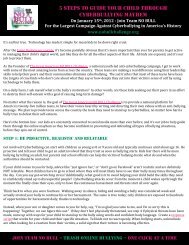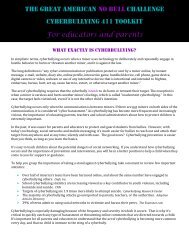The Great American NO BULL Challenge cyberbullying 411 toolkit ...
The Great American NO BULL Challenge cyberbullying 411 toolkit ...
The Great American NO BULL Challenge cyberbullying 411 toolkit ...
Create successful ePaper yourself
Turn your PDF publications into a flip-book with our unique Google optimized e-Paper software.
THE EFFECTS OF CYBER<strong>BULL</strong>YING<br />
A child who suddenly withdraws from social activities, seeks to avoid contact with certain children, suffers from<br />
anxiety-driven headaches or stomachaches before going to school, or disengages in regular activities with others<br />
are some common effects of <strong>cyberbullying</strong>.<br />
Research shows that a child probably won’t tell an adult that they’re being harassed online or by text message. As<br />
they grow older, they are even less likely to say anything. Why is that? Nothing is more important to children than<br />
their cell phone or computer, and some parents believe that taking away their technology will solve the problem.<br />
Children also think that parents, educators, and administrators will get in the middle of the situation by reporting<br />
the bully to other parents, which, in a child’s opinion, makes the problem even more difficult.<br />
Cyberbullying takes many forms like physical threats, harassment, and name calling. It also takes more indirect<br />
actions, such as gossiping or excluding an individual. No matter what form online bullying takes, children are likely<br />
to feel depressed, hurt, and alone. Examples include:<br />
Verbal: Name-calling and teasing<br />
Social: Spreading rumors, leaving people out on purpose, and breaking-up friendships<br />
Psychological: Being threatened or being forced to do things you do not want to do<br />
Racial: Cyberbullying based on a person’s ethnicity, color of their skin, or family background<br />
Sexual: Cyberbullying that abuses someone sexually by inappropriate contact or messages<br />
Because <strong>cyberbullying</strong> is a silent epidemic, it’s also important to pay close attention to a child’s behavior, looking<br />
for things that are inconsistent with how they usually behave, such as:<br />
Unexpected or random bursts of anger<br />
Pattern of withdrawal, shame, fearfulness<br />
Onset of depression, anxiety, low self-esteem<br />
Persistent, vague, unexplained physical complaints<br />
Damaged or missing belongings<br />
Unexplained bruises or injuries<br />
Diminished social contacts and withdraws from close friends<br />
Excuses to avoid school<br />
Decline in grades, falling behind in schoolwork<br />
Trouble sleeping or eating<br />
Drug and alcohol abuse<br />
Becomes evasive when they are asked direct questions<br />
<strong>The</strong> long-term impact of <strong>cyberbullying</strong> is greater than traditional bullying. Computers, cell phones, gaming devices,<br />
and most mobile devices allow a cyberbully's messages to spread instantly. Messages sent to ruin someone's<br />
reputation can be much more damaging than a face-to-face interaction. Instead of the interaction being between<br />
individuals or small groups, written word, photos or videos can be circulated to a large group of people within<br />
minutes. Once harsh words or embarrassing images/videos are posted online, it’s almost impossible to remove<br />
every trace of what has been said or posted.<br />
Common effects for students who are cyberbullied include:<br />
Depression, anxiety, or low self-esteem<br />
Pattern of withdrawal, or shame or fearfulness<br />
Unexpected or random bursts of anger<br />
Physical health problems:<br />
Lack of appetite<br />
Loss of energy<br />
Diminished social contacts or friends<br />
Poor grades or excuses to avoid school<br />
Suicidal thoughts<br />
Drug or alcohol abuse








